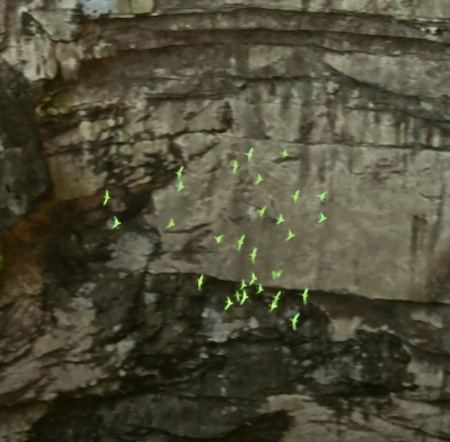Hazards Free fall Discovery 27 December 1966 | Phone +52 482 367 2115 | |
 | ||
Length VR = 515 mEntrance pit:L = 135 mW = 305 mH = 333–376 mAr = 33,110 m² Access To view the top, easy, no restrictions. To descend, a permit must be obtained. Hours Closed now Monday5AM–7:30PMTuesday5AM–7:30PMWednesday5AM–7:30PMThursday5AM–7:30PMFriday5AM–7:30PMSaturday5AM–7:30PMSunday5AM–7:30PM Similar Tamul waterfall, Puente de Dios, Cascadas de Minas Viejas, Las Pozas, Cascadas de Micos | ||
Cave of swallows schwalbenh hle in mexico
The Cave of Swallows, also called the Cave of the Swallows (Spanish: Sótano de las Golondrinas), is an open air pit cave in the Municipality of Aquismón, San Luis Potosí, Mexico. The elliptical mouth, on a slope of karst, is 49 by 62 m wide and is undercut around all of its perimeter, widening to a room approximately 303 by 135 meters (994 by 442 ft) wide. The floor of the cave is a 333-meter (1092 ft) freefall drop from the lowest side of the opening, with a 370-meter (1,214 ft) drop from the highest side, making it the largest known cave shaft in the world, the second deepest pit in Mexico and perhaps the 11th deepest in the world.
Contents
- Cave of swallows schwalbenh hle in mexico
- El sotano de las golondrinas cave of swallows schwalbenh hle
- History
- Geology
- Etymology
- Description
- Extreme sports tourism
- References
El sotano de las golondrinas cave of swallows schwalbenh hle
History
The cave has been known to the local Huastec people since ancient times. The first documented descent was on 27 December 1966 by T. R. Evans, Charles Borland and Randy Sterns.
Geology
The cave is formed in the El Abra and Tamabra formations, limestones of Middle Cretaceous age. The cave's speleogenesis is still not fully known but is a result of solutional enlargement along a vertical fracture, with subsequent vadose enlargement.
Etymology
The cave's Spanish name Sótano de las Golondrinas means Basement of the Swallows, owing to the many birds which live in holes on the cave walls. These are mostly white-collared swifts (vencejos in Spanish) and green parakeets (periquillo quila), but actual swallows are in fact rarely found here.
Each morning, flocks of birds exit the cave by flying in concentric circles, gaining height until they reach the entrance. In the evenings a large flock of swifts circles the mouth of the cave and about once each minute, a group of perhaps fifty breaks off and heads straight down towards the opening. When they cross the edge, the birds pull in their wings and free-fall, extending their wings and pulling out of the dive when they reach the heights of their nests. Watching this has become popular with tourists.
Description
Temperatures in the cave are low. Vegetation grows thickly at the mouth, The cave floor is covered with a thick layer of debris and guano. From the floor at the bottom of the shaft there is a series of narrow pits known as The Crevice, totaling about 140 m (460 ft), which brings the total depth of the cave to 515 m (1,690 ft).
Extreme sports tourism
The cave is a popular vertical caving destination. Cavers anchor their ropes on the low side, where bolts have been installed in the rock and the area is clear of obstructions. Rappelling to the floor can take up to an hour. Climbing back out may take from forty minutes to more than two hours. A person without a parachute would take almost ten seconds to freefall from the mouth to the floor, hence the pit is also popular with extreme sports enthusiasts for BASE jumping. An average-sized hot air balloon has been navigated through the 160-foot (49 m) wide opening and landed on the floor below. BASE jumpers can get out in about 10 minutes using a winch. (video: Journey to the Earth's Core-History Channel).
